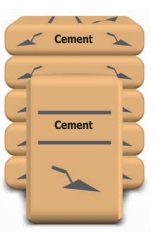Chemistry in Everyday life | Term 3 Unit 3 | 6th Science - Cement and Uses of cement | 6th Science : Term 3 Unit 3 : Chemistry in Everyday life
Chapter: 6th Science : Term 3 Unit 3 : Chemistry in Everyday life
Cement and Uses of cement
Cement
In ancient period,
the houses were constructed by using the mixture of lime, sand and wood. At
present, the people are widely use the cement for construction of houses, dams
and bridges. The cement is manufactured by crushing of naturally occurring
minerals such as lime, clay and gypsum through milling process.

Cement becomes hardened when it is mixed with water. Gypsum plays a very important role in controlling the rate of hardening of the cement. During the cement manufacturing process, a small amount of gypsum is added at the final grinding process. Gypsum is added to control the “setting of cement”.
In
1824, Joseph Aspdin invented Portland cement by burning finely ground chalk and clay
in a kiln. It was named “Portland” cement because it resembled the high-quality
building stones found in Portland, England.
Uses of cement
Cement is used as mortar,
concrete and reinforced cement concrete.
Mortar
Mortar is a paste
of cement and sand mixed with water. In houses, mortar is used to bind building
blocks for constructing walls, to apply coating over them and to lay floor.
Concrete
Concrete is a
mixture of cement, sand and gravel. It is used in the construction of
buildings, bridges and dams.
Reinforced Cement
Concrete
Reinforced cement
concrete is a composite material by mixing iron mesh with cement. This is very
strong and firm. It is used in the construction of dams, bridges, centering
works in houses and construction of pillars. Huge water tanks, water pipes and
drainages are built with this.

Activity 5: Take three empty tumblers of same size and name
them as A, B and C. Add two tea spoonful of cement in each of the container.
Then pour one tea spoonful of water in container A and two spoonful of water in
B and three spoonful of water in C.
After an hour, observe which container of the cement set fast? Touch the containers and see if they are warm or cool. From this experiment, we understand that water and cement should be mixed in a certain ratio for fast setting.
Related Topics